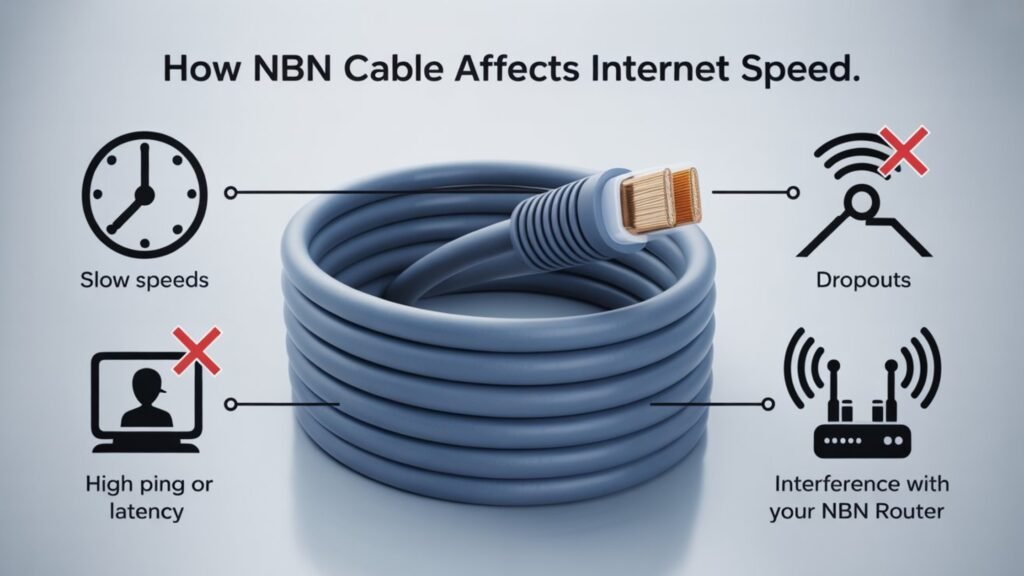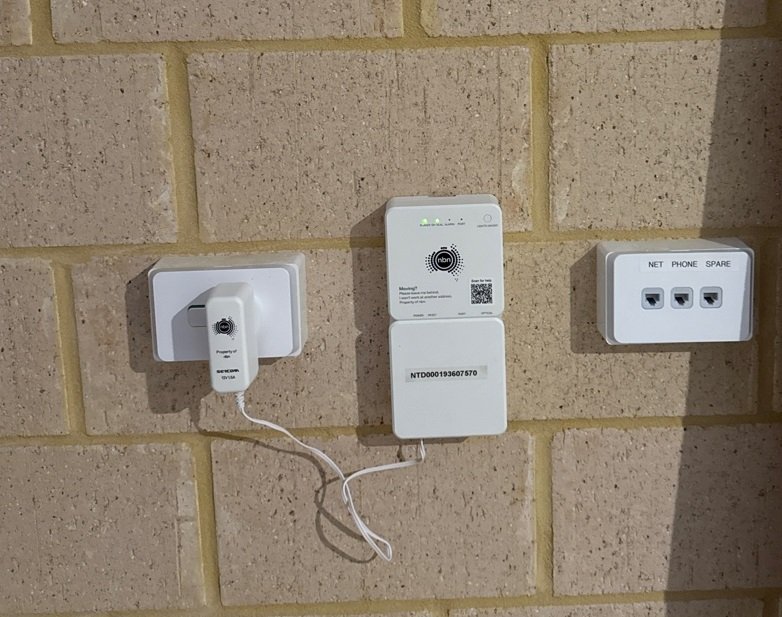What is an NBN Cable?
An NBN cable plays a crucial role in delivering high-speed internet across Australia. Whether you’re connected through Fibre to the Premises (FTTP), Hybrid Fibre Coaxial (HFC), or Fibre to the Curb (FTTC), the type and quality of your NBN cable can significantly affect your internet performance.
In this guide, we’ll break down everything you need to know about NBN cable types, how they function in an NBN connection, how they relate to your NBN router, and tips to optimize speed and stability.

Table of Contents
| Section | Description |
|---|---|
| 1. What is an NBN-Cable? | Basic overview |
| 2. Types of NBN-Cable | Common cable types used in NBN technology |
| 3. How NBN-Cable Affects Internet Speed | Impact on performance |
| 4. NBN Connection Types Using Cables | FTTP, HFC, FTTC, etc. |
| 5. Choosing the Right NBN Router | Compatibility with NBN cable |
| 6. Installation Tips | Best practices |
| 7. FAQs | Common queries answered |
1. What is an NBN Cable?
An Internet Cable is the physical medium that connects your home or business to the National Broadband Network infrastructure. It transmits data from the NBN access point to your premises, typically through underground or aerial lines.
The quality, type, and installation of this cable directly influence:
- Download/upload speeds
- Signal stability
- Latency (especially for gaming or video conferencing)
2. Types of NBN Cable Used in Australia
There are multiple types of NBN Wiring, each suited to different NBN technologies. Here’s a breakdown:
| NBN Technology | Cable Type | Description |
|---|---|---|
| FTTP (Fibre to the Premises) | Fibre Optic Cable | Fastest and most reliable |
| HFC (Hybrid Fibre Coaxial) | Coaxial Cable | Used in areas previously serviced by pay TV |
| FTTC (Fibre to the Curb) | Copper + Fibre | Fibre to curb, copper to premises |
| FTTN (Fibre to the Node) | Copper Cable | Existing copper lines, less reliable |
| Fixed Wireless / Satellite | N/A | No direct NBN cable to home |
Focus Keyword: NBN-cable appears naturally across each entry.
3. How NBN Cable Affects Internet Speed
A good Broadband Cable setup ensures you get the most out of your internet plan. Poor-quality or damaged cables can lead to:
- Slow speeds
- Dropouts
- High ping or latency
- Interference with your NBN router
Key Factors:
- Length: The longer the cable, especially copper, the weaker the signal.
- Interference: Electrical interference can disrupt signals in older copper cables.
- Cable Quality: Newer, shielded cables reduce signal loss.

4. NBN Connection Types Using Cables
Australia’s NBN connection comes in several forms, each using a specific type of cable setup:
Common NBN Connections
- Fibre to the Premises (FTTP)
- Full fibre optic cable from the exchange to your home.
- Offers speeds up to 1000 Mbps.
- Hybrid Fibre Coaxial (HFC)
- Uses coaxial cable from street to home.
- Speeds vary but can reach 250–1000 Mbps.
- Fibre to the Node (FTTN)
- Fibre to a street node; copper cable to home.
- Lower speeds due to copper.
- Fibre to the Curb (FTTC)
- Fibre to the curb, short copper to premises.
- Better than FTTN but not as fast as FTTP.
5. Choosing the Right NBN Router for Your Cable Setup
Your NBN router must be compatible with the cable and technology you’re using. Not all routers work with every NBN connection type.
| NBN Type | Router Requirement |
|---|---|
| FTTP | Any modern router with WAN port |
| HFC | NBN-supplied modem + your own router |
| FTTN | VDSL2-compatible modem/router |
| FTTC | NBN-supplied NCD + compatible router |
Tips:
- Place the NBN router near the main outlet.
- Use short, high-quality Ethernet cables to reduce signal degradation.
- Avoid double NAT by setting your device to bridge mode if using two routers.
6. NBN Cable Installation Tips
Professional installation is always recommended for optimal cable performance, but if you’re troubleshooting or upgrading, here are essential tips:
- Use certified NBN electricians for any internal cabling changes.
- Avoid DIY fixes on main NBN cabling.
- Check for corrosion or visible damage on exposed cables.
- Ensure wall sockets and splitters are in good condition.
Tools Professionals Use:
- Cable testers
- Signal strength meters
- Shielded patch cables
- Crimping tools
7. Frequently Asked Questions (FAQs)
What is the difference between NBN cable and Ethernet cable?
An Broadband Cable refers to the infrastructure delivering broadband (like coaxial or fibre), while Ethernet cables are used inside your home to connect devices to your NBN router.
Can I upgrade my NBN cable?
You can’t upgrade the external Broadband Cable yourself, but you can request a technology upgrade via NBN Co or improve internal cabling with a licensed technician.
How do I know which NBN cable I have?
Check your NBN installation type via your provider or look at the modem/NBN box model (e.g., FTTP boxes are different from HFC modems).
Does the NBN-cable affect gaming performance?
Yes. Poor quality or long copper cables (FTTN) introduce latency and lag. Opt for FTTP or HFC for better gaming performance.
Related Topics (People Also Search For)
- NBN modem vs router
- Best placement for NBN router
- How to boost NBN Wi-Fi signal
- What is the NBN connection box?
- NBN installation timeframes
Conclusion
Understanding your NBN cable type and ensuring high-quality installation is essential for fast, reliable internet. Whether you’re on FTTP, HFC, or FTTC, the cable and NBN connection setup dictate how well your service performs. Pair this with the right NBN router, and you’re on your way to seamless streaming, gaming, and working from home.
For expert help with NBN cable upgrades or troubleshooting, always consult a professional service.
Need reliable NBN repairs or upgrades? Visit Value Services NBN Repairs today and get fast, expert assistance to keep your internet running smoothly.

